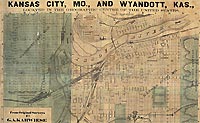On January 21, 1879, the Kansas Senate passed a resolution that approved the annexation of Kansas City, Missouri. The Missouri legislature refused to adopt a corresponding resolution, however, and this attempt to incorporate Kansas City into Kansas went nowhere. Interestingly, it was just one of several attempts in the nineteenth century to annex Kansas City to Kansas.
The first push for the border alteration actually came from Missouri in the pre-Civil War years. In 1855, Mobillion W. McGee, a proslavery resident of Westport, Missouri, believed that if the Kansas territory annexed Kansas City and Westport it would gain thousands of proslavery sympathizers who could vote to make Kansas a slave state when it entered the Union.
No records of this attempt survived, but according to a Kansas City newspaperman named Robert T. Van Horn, he and Mobillion McGee gained the consent of a majority of the Missouri legislature and the Kansas territorial legislature at Shawnee Mission, Kansas, to move the Kansas border. A third associate, whose identity was never revealed by the other plotters, disappeared with a love interest before he could gain necessary approval from members of the U.S. Congress. The proposals never came to a vote in any of the legislative bodies.
The Civil War settled the slavery debate, but annexation plans still had widespread support in Kansas and in Kansas City due to potential economic benefits. In the 1870s, annexation supporters proposed a number of plans, several of which called upon Kansas to "purchase" the city from Missouri.
In 1878, the Kansas City Times began publishing articles in favor of annexation, arguing that the bulk of Kansas City’s trade already took place with towns in Kansas. Most Kansas City residents, according to the paper, considered themselves to be Kansans, regardless of the lines on a map. Furthermore, much of the area’s development was occurring in what would in 1886 become Kansas City, Kansas. The area’s emerging cities would essentially end up as one metropolis, yet the state line spurred economic and political divisions that could potentially impair growth on both sides. The Times articles reasoned that in consideration of Kansas City’s desire to be annexed, Missouri would agree to the plan, provided that it was allowed to retain all tax revenue from Kansas City for a period of 50 years.
This second movement for annexation culminated with the 1879 Kansas Senate resolution. The Kansas House voted in favor of the plan several days later, and the legislature awaited consent from Missouri and the U.S. Congress. It was the first time that the Kansas legislature officially attempted to annex Kansas City. Dozens of Kansas City business leaders and politicians pressed the Missouri legislature to concur with the resolution, but the city was now far more valuable than it had been in 1855 when Missouri was (according to Van Horn) willing to relinquish it. With no real incentive for Missouri to give up Kansas City, the Kansas-Missouri border remained stationary.
Further attempts to annex Kansas City occurred in 1884 and 1899. Throughout this time, Kansas City residents frequently claimed that surveyors failed to account for the changing routes of the Kansas and Missouri Rivers when determining the border. Therefore, the surveyors allegedly placed the Kansas-Missouri border six miles too far to the west in relation to the original Missouri state charter.
Proponents of annexation lobbied the Kansas legislature to bring the matter to the U.S. Supreme Court in 1899, but to no avail. Reputable surveys undertaken at the time confirmed that the border was actually in the correct location. Since the movements for the annexation of Kansas City to Kansas in the nineteenth century, no more serious attempts have been made. Kansas City, Missouri, appears destined to remain in Missouri and confuse generations to come.
Read a biographical sketch of Robert Van Horn (1824-1916), Newspaperman and Civic Leader, prepared by Barbara Magerl, the Missouri Valley Special Collections, The Kansas City Public Library, 2003.
Check out the following books and articles about the attempted annexations of Kansas City.
- "When Kansas City, Mo., Came Close to Being a City in Kansas," by Robert W. Patrick; in Kansas History: A Journal of the Central Plains, volume one, winter 1978, pp. 266-277
- "The Attempted Annexation of Kansas City to the State of Kansas," by Floyd C. Shoemaker and Henry C. Haskell; in the Missouri Historical Review, 1950
- City of the Future: A Narrative History of Kansas City, 1850-1950, by Henry C. Haskell and Richard B. Fowler; contains a brief overview of the annexation attempts in the 1850s and 1870s, pp. 84-88
Continue your research on Robert T. Van Horn using archival material from the Missouri Valley Special Collections.
- Robert T. Van Horn Compilation of Secondary Sources
- Robert Van Horn Microfilm: Native Sons Scrapbooks, Roll 69
- Robert Van Horn Letters
- Van Horn and Abeel's Printing House
References:
Haskell, Jr., Henry C. and Richard B. Fowler. City of the Future: A Narrative History of Kansas City, 1850-1950. Kansas City, MO: Frank Glenn Publishing, 1950.
Patrick, Robert W. "When Kansas City, Mo., Came Close to Being a City in Kansas." Kansas History: A Journal of the Central Plains 1 (Winter 1978): 266-277.



